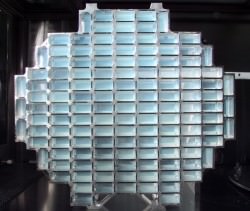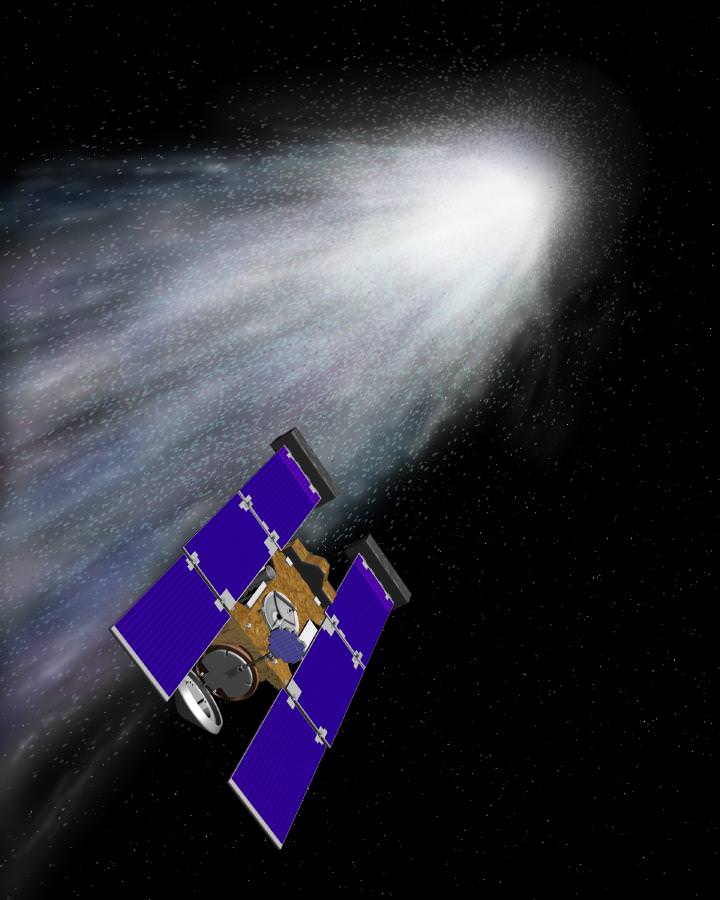[/caption]
NASA scientists studying the comet samples returned by the Stardust spacecraft have discovered glycine, a fundamental building block of life. Stardust captured the samples from comet Wild 2 in 2004 and returned them to Earth in 2006. “Glycine is an amino acid used by living organisms to make proteins, and this is the first time an amino acid has been found in a comet,” said Dr. Jamie Elsila of NASA’s Goddard Space Flight Center. “Our discovery supports the theory that some of life’s ingredients formed in space and were delivered to Earth long ago by meteorite and comet impacts.”
Proteins are a major component of all living cells, and amino acids are the building blocks of protein. Just as the 26 letters of the alphabet are arranged in limitless combinations to make words, life uses 20 different amino acids in a huge variety of arrangements to build millions of different proteins.

As Stardust passed through dense gas and dust surrounding the icy nucleus of Wild 2 (pronounced “Vilt-2”), special collection grids filled with aerogel – a novel sponge-like material that’s more than 99 percent empty space – gently captured samples of the comet’s gas and dust. The grid was stowed in a capsule which detached from the spacecraft and parachuted to Earth on January 15, 2006. Since then, scientists around the world have been busy analyzing the samples to learn the secrets of comet formation and our solar system’s history.
Earlier, preliminary analysis in the Goddard labs detected glycine in both aluminum foil that lined the collection grids, as well as in a sample of the aerogel. However, since glycine is used by terrestrial life, at first the team was unable to rule out contamination from sources on Earth. “It was possible that the glycine we found originated from handling or manufacture of the Stardust spacecraft itself. We spent two years testing and developing our equipment to make it accurate and sensitive enough to analyze such incredibly tiny samples,” said Elsila. The new research used isotopic analysis of the foil to rule out that possibility.
Isotopes are versions of an element with different weights or masses; for example, the most common carbon atom, Carbon 12, has six protons and six neutrons in its center (nucleus). However, the Carbon 13 isotope is heavier because it has an extra neutron in its nucleus. A glycine molecule from space will tend to have more of the heavier Carbon 13 atoms in it than glycine that’s from Earth. That is what the team found. “We discovered that the Stardust-returned glycine has an extraterrestrial carbon isotope signature, indicating that it originated on the comet,” said Elsila.
Another team member Dr. Daniel Glavin said, “Based on the foil and aerogel results it is highly probable that the entire comet-exposed side of the Stardust sample collection grid is coated with glycine that formed in space.”
The team’s research will be published in the journal Meteoritics and Planetary Science.
Source: NASA


Comet Wild 2 is a periodic comet orbiting near the plane of the ecliptic indicating that it probably originated in the Kuiper Belt. Its origin in the Kuiper Belt or possibly the Oort Cloud means that this comet was probably formed as our solar system was created.
What would be really interesting would be to sample a more exotic cometary body. Say one from the Oort cloud or even further out aka… an interloper from interstellar space.
Brings up two thoughts: 1) Was the glycine associated with specific particles or impacts in the aerogel, and did these provide any other evidence of microbes in comets, as theorized by Dr. Wickramasinghe? If his theory is just wrong, it’s about time for him to stop saying it. 2) If space if full of organics, then why have none been reported on Mars? The identification of the “Sinton bands” as spectroscopic evidence of organics on Mars – over 4 decades ago – remains in scientific limbo. We found water on Mars and we’re not going to analyze it for organics or life? Is this why we pay these folks?
i think this discovery suggests more about the probability of life elsewhere in the cosmos than it does about the origin of life on earth.
You mean like, err… Anaconda’s brain?
Thanks for bringing this to my attention, and thanks for the good questions raised in the thread:
Good idea. Perhaps one can establish when and how and how much glycine is made.
Truly good catch. These organics were tested as cometary just because they haven’t been participating in metabolism. It is this that tends to ramp up the ratio of lighter isotopes in use.
So this should AFAIU be a serious blow to Wickramasinghe’s ideas. (Just as the seemingly unprocessed “cometary like” organics of Enceladus eruptions means there is less hope for life from within cometary like bodies.) His ideas are really out there, so he will probably claim otherwise though.
NASA has, twice, but both time oxidizers have ruined the tests. (Both the cold test for Viking (heavy oxidizer), and the heated one for Phoenix (light oxidizer).)
Right now it looks ambiguous IMHO. The detected methane (no isotope ratio as of yet) is AFAIU produced at high rates but also destroyed 2-3 orders of magnitude faster than models can account for. If it’s surface activity, something breaks down organics in these areas in ~ 1 hour.
This triggers a pet peeve of mine. Just as the standard genetic code is modified in sundry cases (for example in mitochondria), evolution has tacked on more AAs than in the standard code. This is done by posttranslational modification (PTM) which exponentially increase the variability of AAs.
One such AA is selenocystein:
Another is pyrrolysine:
I’m not a biologist, and I can easily have misunderstood. But the scope of a list of PTMs, and its exceptions in sundry phyla, is truly astounding.
Btw, I’ve never heard of those “Sinton bands” before. Googling, they seem to be mostly attributed to HDO (from fractional escape of atmosphere), and the rest (i.e. any CH contributions) surely must be encompassed or at least superseded by the modern spectroscopic evidence of CH4.
Organic substances are not necessarily derived from living things. They are substances with a carbon skeleton and are detected spectroscopically. They are common thruout the universe. Except for glycine, earthly amino acids display an inherent dissymetry – a give-away for once-living organics. An imbalance in the symmetry of certain amino acids has been reported in meteoric samples – perhaps a tantalizing clue to the origins of life.
If I read the published papers correctly, HDO in the atmosphere of Mars was only a plausible explanation of the “Sinton Bands” if the H:D ratio was near 1:1, which has since been shown false (the ratio is closer to the Earth value, but somewhat higher). Dr. Bell has a paper where he assumes the source for the “Sinton bands” is not organic, and proposes it is some mineral. Not a very good track record of finding organics on Mars for 50 years of science, especially since organics (as neoguru says) are “common thruout the universe”.